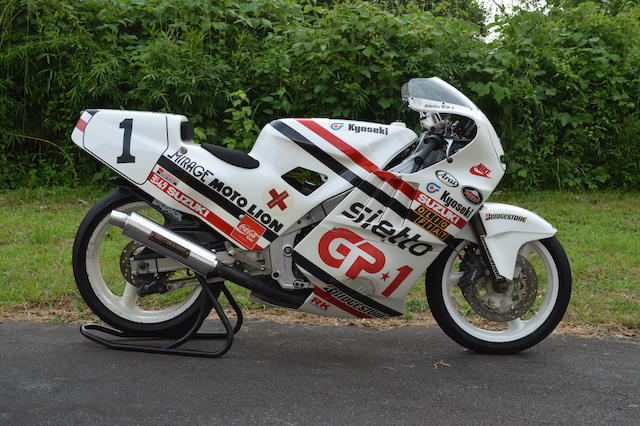* 7-liter V-8 with 700+ bhp * Brutally fast 200mph endurance racer * Genuine Greenwood Customer Car * Wild 'Wide-body' styling * Period IMSA race history * Professionally restored * From the Tom Armstrong Collection The late 1970s were a riotous, raucous time in sports car racing. Sanctioning bodies were in disarray, searching desperately for ways to overcome the lingering resentment of the '73 oil embargo. Porsche's 935s defined the era. Loosely based on looking something like a 911, it spawned a divergent entry of "silhouette" racers and set the tone for brave, imaginative competitors who sought to develop something, anything, that would be competitive with it. One element that remained constant through that period was the appeal of big, strong, loud American V-8s and the sports car made for them, the Chevrolet Corvette. The leading proponent of the genre was John Greenwood John's father worked at the GM Tech Center and John grew up building engines and street racing around Michigan. John didn't get a racing license until 1969 but immediately showed his competence by winning the 1970 and 1971 SCCA A/Production championship in a 427 Corvette of his own construction. It was the first showcase for his talent for combining strong engines with refined suspensions and advanced aerodynamics. Greenwood's Corvette quickly attracted attention, including comedian Dick Smothers who co-drove in some endurance events and BFG, who noticed Greenwood's victory in a street tire endurance race and conceived the idea of promoting their street Radial T/A tires by competing at the most important endurance races, Daytona, Sebring, Watkins Glen and of course the 24 Hours of Le Mans. It was audacious, as were the Corvettes that John Greenwood had developed. The Stars and Stripes livery, conceived by Greenwood and executed by GM Design's Randy Wittine, distinguished the BFG Corvettes and became legend. So did their thundering performance. After the two-year BFG deal was done Greenwood began development on the series of Greenwood Corvettes that would help define the "silhouette" era, the Wide Bodies introduced in 1974. The Wide Body Corvettes were a successful collaboration between Detroit-based Greenwood and a sub-rosa culture of enthusiastic racers within GM, the most prominent of whom was Zora Arkus-Duntov. Duntov never wavered in his support of the Corvette or racers determined to make it competitive and the free-form rules of IMSA GTX (Grand Touring Experimental) give him and his compatriots the latitude to implement ideas that had no hope of surviving the anti-racing suits at GM. Aerodynamics became key to performance when 700+ horsepower engines began to push the Greenwood Corvettes to over 200mph down the long straights of Le Mans and around the mixed oval/road courses of IMSA. Duntov conceived the lowered, raked, chiseled nose with molded integrated flares to cover the ultra-wide slick tires needed to handle the weight and power of the Corvette. To achieve maximum rake and best air penetration the whole body was lowered over the frame, especially at the front. It was Greenwood's solution to the wide fenders that became the signature design element of the Wide Body cars, the vast openings at the rear of the fenders. In addition to preserving square feet of nearly horizontal surface for aerodynamic downforce they dumped under-fender turbulence created by the big tires with minimal disturbance to the body's airflow. It was a flash of brilliance quickly recognized and copied by BMW and others and became one of the functional trademarks of the silhouette era. GM's Randy Wittine translated the concept into an integrated whole and Bob Riley collaborated on refining chassis and suspension design based on the stock Corvette frame and suspension. The rear suspension trailing arms were notched for tire clearance and the rear frame was sectioned, then thoroughly reinforced by a network of triangulated tubes that also formed the roll cage. Riley's suspen
* 7-liter V-8 with 700+ bhp * Brutally fast 200mph endurance racer * Genuine Greenwood Customer Car * Wild 'Wide-body' styling * Period IMSA race history * Professionally restored * From the Tom Armstrong Collection The late 1970s were a riotous, raucous time in sports car racing. Sanctioning bodies were in disarray, searching desperately for ways to overcome the lingering resentment of the '73 oil embargo. Porsche's 935s defined the era. Loosely based on looking something like a 911, it spawned a divergent entry of "silhouette" racers and set the tone for brave, imaginative competitors who sought to develop something, anything, that would be competitive with it. One element that remained constant through that period was the appeal of big, strong, loud American V-8s and the sports car made for them, the Chevrolet Corvette. The leading proponent of the genre was John Greenwood John's father worked at the GM Tech Center and John grew up building engines and street racing around Michigan. John didn't get a racing license until 1969 but immediately showed his competence by winning the 1970 and 1971 SCCA A/Production championship in a 427 Corvette of his own construction. It was the first showcase for his talent for combining strong engines with refined suspensions and advanced aerodynamics. Greenwood's Corvette quickly attracted attention, including comedian Dick Smothers who co-drove in some endurance events and BFG, who noticed Greenwood's victory in a street tire endurance race and conceived the idea of promoting their street Radial T/A tires by competing at the most important endurance races, Daytona, Sebring, Watkins Glen and of course the 24 Hours of Le Mans. It was audacious, as were the Corvettes that John Greenwood had developed. The Stars and Stripes livery, conceived by Greenwood and executed by GM Design's Randy Wittine, distinguished the BFG Corvettes and became legend. So did their thundering performance. After the two-year BFG deal was done Greenwood began development on the series of Greenwood Corvettes that would help define the "silhouette" era, the Wide Bodies introduced in 1974. The Wide Body Corvettes were a successful collaboration between Detroit-based Greenwood and a sub-rosa culture of enthusiastic racers within GM, the most prominent of whom was Zora Arkus-Duntov. Duntov never wavered in his support of the Corvette or racers determined to make it competitive and the free-form rules of IMSA GTX (Grand Touring Experimental) give him and his compatriots the latitude to implement ideas that had no hope of surviving the anti-racing suits at GM. Aerodynamics became key to performance when 700+ horsepower engines began to push the Greenwood Corvettes to over 200mph down the long straights of Le Mans and around the mixed oval/road courses of IMSA. Duntov conceived the lowered, raked, chiseled nose with molded integrated flares to cover the ultra-wide slick tires needed to handle the weight and power of the Corvette. To achieve maximum rake and best air penetration the whole body was lowered over the frame, especially at the front. It was Greenwood's solution to the wide fenders that became the signature design element of the Wide Body cars, the vast openings at the rear of the fenders. In addition to preserving square feet of nearly horizontal surface for aerodynamic downforce they dumped under-fender turbulence created by the big tires with minimal disturbance to the body's airflow. It was a flash of brilliance quickly recognized and copied by BMW and others and became one of the functional trademarks of the silhouette era. GM's Randy Wittine translated the concept into an integrated whole and Bob Riley collaborated on refining chassis and suspension design based on the stock Corvette frame and suspension. The rear suspension trailing arms were notched for tire clearance and the rear frame was sectioned, then thoroughly reinforced by a network of triangulated tubes that also formed the roll cage. Riley's suspen



.jpg)










Testen Sie LotSearch und seine Premium-Features 7 Tage - ohne Kosten!
Lassen Sie sich automatisch über neue Objekte in kommenden Auktionen benachrichtigen.
Suchauftrag anlegen